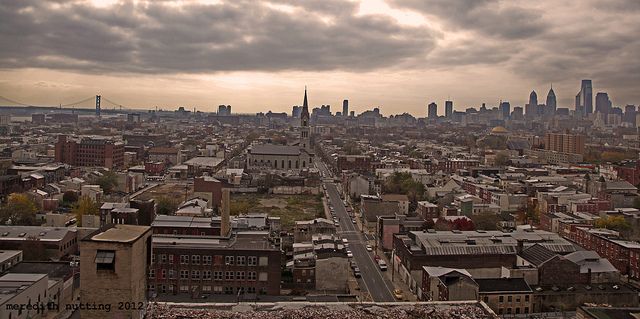Ways & Means is a weekly column by Mark Alan Hughes on economics, politics and sustainability in Philadelphia.
On Monday, I sat on a panel organized by the United Nations and the Sustainable Energy Fund at the National Constitution Center. It was meant to rollout the UN’s new Sustainable Energy For All campaign, which commits to bringing electricity to the 1.3 billion people in the world (that’s one person in five) who now have none, while doubling the global rate of energy efficiency and share of renewable energy.
As is often done, I was given some questions to prepare for discussion. And I must say, I was impressed by how much the questioners knew about Philadelphia. Call me provincial, but it felt good to see UN and federal bigwigs platform Philly specifics as a global model.
Thankfully, the actual panel was a bit more freewheeling than just answering prepared questions. Still, I thought the questions might make a good column. And I throw in my attempts to answer four of them:
Unlike developing countries, the U.S., for the most part, does not face the challenge of access to modern energy, particularly electricity. Why do you think the first energy target of the Sustainable Energy for All initiative would be or should be of any concern to U.S. citizens?
First, in every sense, there are ethical arguments for committing to sustainable energy for all. By training and temperament, I’m not adept at making these arguments myself. But I can be moved by them as a citizen and respect those who make them. They mobilize large communities of faith, social justice and legal principle who can act collectively beyond the incentives of self-interest.
But even in terms of self-interest, Americans and Philadelphians have a stake in global energy access. Emissions are growing rapidly among the emerging economies. Unless we assist in helping these economies meet their aspirations in a more sustainable way, we will lose control over our own climate and energy future.
Some people argue that introducing renewable energy and increasing energy efficiency would create a rebound effect. In other words, cheaper energy could mean that there is an incentive for more energy to be consumed in a more wasteful manner. This would result in higher energy consumption at the aggregate level. Could cheaper renewable energy ultimately hinder achieving more sustainable energy consumption patterns? What is the evidence for this so-called rebound effect?
It’s important to note first that rebound effect, in this context, refers to energy efficiency (and actually to below-cost energy efficiency improvements, the great stuff many folks advocate because they more than pay for themselves over time) and not to renewable energy.
Rebound refers to the well-understood behavior of economic actors: When the price of something falls, consumers use more of it. This happens in many ways — a direct effect where businesses and consumers use more of the cheaper energy, a substitution effect where people change their consumption toward items that make use of cheaper energy, and an indirect effect where savings from cheaper energy mean people spend more on other things that still take energy to produce. In this way, making energy cheaper, by using less of it through energy efficiency, can actually lead to more overall energy use.
In economic terms, all of this is good. It’s the basic story of how productivity leads to growth. And below-cost energy efficiency is particularly productive because the growth pays for itself. Estimates of the size of the rebound effect range from 20 percent or less among those who think it is a small problem to 50 percent or more among those who think it is a large problem.
For most economic activity, these would be measures of good things: How much better off we are because we’ve learned to get more out of the same amount of energy. The problem arises from the environmental costs of energy consumption, largely external to market prices that come from using carbon-intensive sources.
If energy efficiency is promoted as positive economic development, then fine. But if energy efficiency is promoted as positive climate action, then it is very important to take into account rebound that would likely reduce net emissions less than net economic savings.
In fact, rebound is a major argument for the use of both carbon pricing and renewable energy. By raising the price of below-cost energy efficiency through a carbon tax or related measures, the effects of rebound can be blunted while still generating revenues that can support climate goals, such as decarbonizing the energy supply through renewables. If the renewable energy supplies the increase in total energy use that rebounds from energy efficiency, then there is no environmental downside and only the economic development upside.

Credit: Alonso Javier Torres on Flickr
Philadelphia now has what is called the “Energy Efficient Buildings Hub (EEB Hub),” commissioned by the U.S. Department of Energy. But this prompted a heated debate on the appropriate level of government intervention in the energy arena. Why do you think the Energy Efficient Buildings Hub is a good thing? Why was it necessary for the federal government to intervene?
If there was a heated debate prompted by the EEB Hub, I missed it. But it’s a good question, and probably even a good debate.
After attending the 2009 Copenhagen climate talks, I’ve come to the conclusion that local and state governments will remain the most productive vehicles for policy development on energy and climate for several years. Global and national solutions are absolutely necessary to achieve the kind of change needed to avoid climate catastrophe, as well as to achieve just and equitable outcomes for all. But leadership by cities provides a path to those global and national solutions.
Cities and regions are proving to both businesses and citizens that commitments, mechanisms and outcomes are possible. To me, this derives largely from the less abstract, less polemical nature of place-informed and place-based policy making. This dynamic is very familiar in the U.S. Especially on energy and climate issues, California is a window on what the rest of the country will look like in 10 or 20 years. It’s been that way on litter, air and water pollution, auto safety and emissions, appliance standards and now carbon pricing. And cities throughout the U.S., regardless of regional political culture, are playing a similar proof-of-concept role.
What’s interesting about the Hub in this vein is the hypothesis that improving the energy performance of buildings has critical region-specific aspects that can only be understood regionally. The DOE made a very significant policy research decision when it conceived of a hub designed to transform a regional market. The idea is that climate, building stock, state and city regulations, the practices of design and supply firms in a region all combine to create local factors in any solution to improving performance.
And yet learning how to unlock the value of building energy performance, which we’ve talked about for at least 40 years, is expensive and demands concentrated resources. This means the Hub needs national funding to prove that market transformation can happen in any region before we can address what is needed for it to happen in every region. This is a smart science agenda, but sometimes difficult to sustain in a federal system in which many regions make powerful claims on resources.
In one of your media interviews on energy efficiency earlier this year, you said that energy efficiency was “never about carbon reduction; it’s about poverty reduction. It’s not about polar bears; it’s about prosperity.” But isn’t energy efficiency equally important for alleviating the burden on the environment as well as increasing economic benefit for consumers?
The complete thought in the quote is actually about the Greenworks program and the responsibility of political leaders to meet constituents where they live. Philadelphia has the highest poverty rate among the 10 largest U.S. cities, coupled with the highest school dropout and lowest college attainment rates among cities of almost any size.
One of the strengths of sustainability as an organizing device for policy strategy is its creation of multiple benefits from single costs. And these co-benefits have the political and rhetorical advantage of being emphasized differently with different constituencies.
Perhaps most Philadelphians rightly worry more about the immediate need for a household-sustaining job than about the need for an Earth-sustaining economy that produces that job. Many of us believe these factors work in concert and that each is the best way to get the other. But it is an important rhetorical decision how much to emphasize each with whom and when.
Mark Alan Hughes teaches at PennDesign and was Philadelphia’s founding director of sustainability.

Mark Alan Hughes is a Distinguished Senior Fellow at PennDesign and an Investigator at the US Department Of Energy’s Energy Efficient Buildings Hub at the Philadelphia Navy Yard. He is a Faculty Fellow of the Penn Institute for Urban Research, a Senior Fellow of the Wharton School’s Initiative for Global Environmental Leadership, and a Distinguished Scholar in Residence at Penn’s Fox Leadership Program. He has been a senior fellow at the Brookings Institution, the Urban Institute, and a senior adviser at the Ford Foundation. He was the Chief Policy Adviser to Mayor Michael Nutter and the founding Director of Sustainability for the City of Philadelphia, where he led the creation of the Greenworks plan. Hughes holds a B.A. from Swarthmore and a Ph.D. from Penn, joined the Princeton faculty in 1986 at the age of 25, has taught at Penn since 1999, and is widely published in the leading academic journals of several disciplines, including Economic Geography, Urban Economics, Policy Analysis and Management, and the Journal of the American Planning Association, for which he won the National Planning Award in 1992.
















